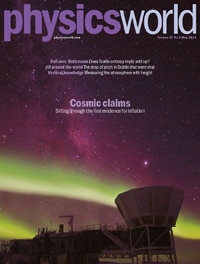By Matin Durrani
It’s always surprising to see the kinds of things that go viral – who’d have thought that a blog with amusing animal pictures would prove such a hit or that a chubby Korean pop singer would clock up nearly two billion views on YouTube?
But I doubt anyone could have predicted that a video of a drop falling from an antique funnel of pitch at a lab at Trinity College Dublin would become one of the science stories of 2013. In fact, here at Physics World we didn’t even write about it at the time.
Partly to make amends, the May issue of Physics World magazine, which is now out, includes a fabulous article by Shane D Bergin, Stefan Hutzler and Denis Weaire from the lab in Dublin where the experiment is based. In the article, they explain the science behind the pitch drop, discuss the history of the experiment and reflect on the value of “slow science” to a hyper-connected, social-media world.

Speculating on why the video proved so popular, the authors cite a recent New Yorker article, which warns that the more we mine data on viral content in order to work out why people share some things and not others, the less likely it will be for what we know about why things go viral to remain true. In other words, we may be changing what will become popular as we’re studying it. “It’s almost quantum mechancial,” Bergin and colleagues point out.
If you’re a member of the Institute of Physics (IOP), you can read the pitch-drop article in all its glory in the digital edition of the magazine on desktop or via the Physics World app, available from the App Store and Google Play. If you’re not yet in the IOP, you can join as an IOPimember for just £15, €20 or $25 a year to get a full year’s access to Physics World both online and through the apps. (An online version of the article can be read here.)
Elsewhere in the May issue of Physics World, we examine the controversial ideas of Brazilian physicist Constantino Tsallis, whose views on entropy not only threaten to undermine Boltzmann’s conventional understanding of disorder, but have a myriad of applications too, especially in medical physics. We also look at how the EarthCARE satellite will map processes occurring in the atmosphere as a function of height. And in case you missed the exciting findings about the early universe by the BICEP2 collaboration, Tushna Commissariat rounds up what the researchers claim to have seen – and whether their findings stand up to scrutiny. Finally, another highlight in the digital edition is an exclusive video interview with nanotechnology pioneer Mildred Dresselhaus from the Massachusetts Institute of Technology.
For the record, here’s a a run-down of the highlights of the issue.
• Sifting the first evidence for inflation – Does BICEP2’s measurement of primordial B-mode polarization open a window on the early universe or has it fallen foul of an unexpected signal from galactic radio loops? Tushna Commissariat investigates
• Rebirth of the stellerator – A technology largely abandoned by plasma physicists is making a comeback and might even be the one to give us commercial fusion energy, as Edwin Cartlidge reports
• Turning a blind eye – Penny Gowland calls for publishers to implement
“double-blind” peer review – where not only are the reviewers anonymous, but the authors too
• Why don’t they listen? – Robert P Crease thinks he might know why science has lost its authority when it comes to political decisions
• The drop heard around the world – When physicists at Trinity College Dublin began looking after an antique funnel full of pitch, they had no idea their humble experiment would spawn one of 2013’s most “viral” news stories. Shane D Bergin, Stefan Hutzler and Denis Weaire reflect on the value of “slow science” to a hyper-connected, social-media world
• Roll over, Boltzmann – To many physicists, “Tsallis entropy” has been a revolution in statistical mechanics. To others, it is merely a useful fitting technique. Jon Cartwright tries to make sense of this world of disorder
• Unravelling our atmosphere – A main limiting factor in climate predictions is that we do not understand atmospheric processes as a function of height. An upcoming European and Japanese space mission called EarthCARE seeks to remedy this, as Martin Caldwell explains
• All alone in the universe? – Jack J Lissauer reviews Five Billion Years of Solitude by Lee Billings
• The problem of missile defence – Philip Webber reviews Arguments that Count by Rebecca Slayton
• Looking for space – Kyle Palmer from Airbus Defence and Space describes how his childhood dream of space travel led to a career at Europe’s largest satellite firm
• Careers and people – Mildred Dresselhaus from Massachusetts Institute of Technology describes her career in science in two special videos with Physics World
• Lateral Thoughts: “Advance” quantum mechanics – John Swanson wonders whether the delayed 20:08 train from Bristol Parkway is the same as the train about to leave at 20:08 from Bristol Parkway
Enjoy the issue – and if you have any thoughts on the articles, do e-mail us at pwld@iop.org
(Oh, and if you want to know more about why things go viral, check out this new article by BuzzSumo, which analysed some 100 million pieces of content.)



